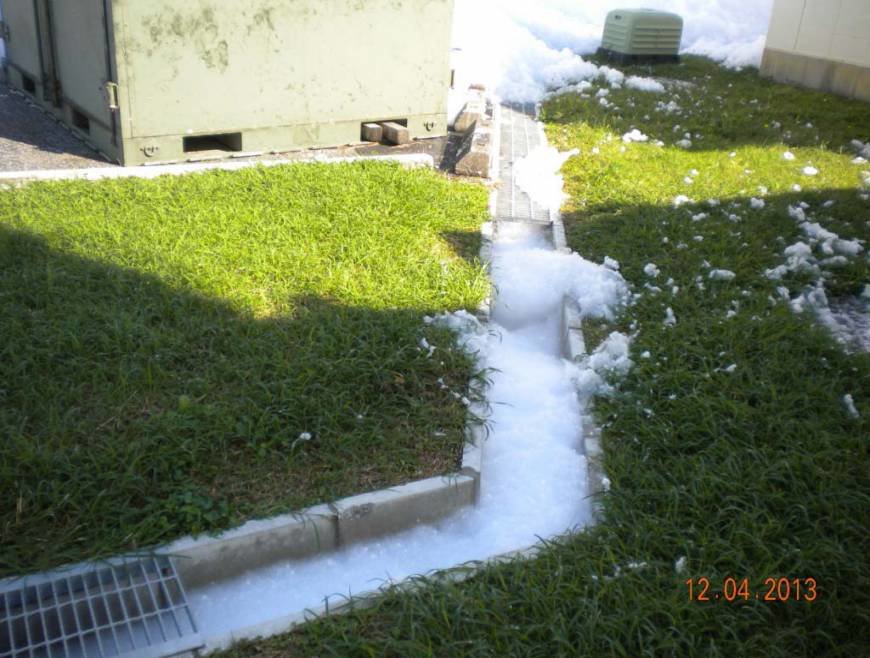
The internal reports expose a spate of accidents at the base during the past 15 years that have involved at least 21,000 liters of fire extinguishing agents — some of them toxic.
In one incident last May, described by base officials as "vandalism," a drunk U.S. Marine activated a firefighting system. It filled a hangar with more than 1,500 liters of JET-X 2.75 percent — a foam classified by the U.S. government as hazardous. It contains chemicals known to cause cancer, and neurological and reproductive disorders.
Although the agent flowed off the base into nearby waterways and the ocean, military officials decided not to report the accident to Japanese authorities or local residents.
Other incidents at Kadena, the largest U.S. air base in the Pacific, included the escape of approximately 17,000 liters of fire extinguishing agents during a three-day period in 2001, attributed by base officials to mechanical and electronic malfunctions.
Further leaks between 2012 and 2014 totaled more than 3,400 liters. One was blamed on malfunctioning equipment and another on mechanical failure. A third incident that spilled 1,135 liters was recorded as "operator error."
The revelations appear to confirm suspicions in Okinawa that the base has been polluting the local water system.
Last month, Okinawa authorities announced that high levels of Perfluorooctanesulfonate (PFOS) — an ingredient found in many fire extinguishing agents — had been discovered in waterways near the Kadena base. The area supplies drinking water to seven municipalities, including the prefectural capital, Naha.
According to an announcement Jan. 18 by the Okinawa Prefectural Enterprise Bureau, tests conducted between February 2014 and last November recorded maximum PFOS levels of 80 nanograms per liter (ng/L) at its Chatan Purification Plant, rising to 1,320 ng/L in the Dakujaku River, which is fed by water from the base. The bureau also noted that readings from a well within the base in 2008 measured 1,870 ng/L.
The U.S. Environmental Protection Agency (EPA) categorizes PFOS as an "emerging contaminant" that is readily absorbed by oral ingestion, accumulating in the blood, kidneys and liver. It does not break down easily in the environment or the human body, where it has a half-life of up to nine years.
Due to concerns that PFOS can lead to reproductive and developmental problems, the EPA in 2009 set a provisional health advisory limit for drinking water at 200 ng/L for short-term exposure. Although the Japanese government has not yet set any specific limits, it has fundamentally prohibited production and use of PFOS-containing products since 2010.
The bureau noted that PFOS levels discovered near Kadena Air Base are far higher than other places in Japan: During the past 10 years, the highest reading in any other part of the country never exceeded 22 ng/L.
On Jan. 21, the director of the Enterprise Bureau asked the Okinawa Defense Bureau to seek permission from the U.S. military to access the base to check for sources of contamination. Last year, Japan and the U.S. signed an environmental agreement that theoretically grants Japanese authorities the right to visit military installations in the case of chemical spills. The Kadena contamination issue may serve as a test case for the new agreement.
U.S. Forces Japan did not respond to a request for comment on the recent accidents or if Okinawan officials would be granted access to the base.
The FOIA documents highlight the shortcomings of Japan Environmental Governing Standards (JEGS), the guidelines regulating contamination on U.S. bases in Japan.
While JEGS requires the U.S. military to notify the Japanese government immediately when "a significant spill . . . threatens the local Japanese drinking water resource," the decision on whether to categorize a spill as "significant" is often left to the discretion of the U.S. military.
In the case of the drunk marine's dumping of the carcinogenic agent last year, correspondence suggests that base officials at first mistakenly identified the chemical as "nontoxic."
By the following month they had recognized it as hazardous and they were aware it carried warnings that it should not be released into the environment. However, even though the agent had entered nearby waterways and the sea, because the names of its component ingredients were not listed in the JEGS table of hazardous chemicals, base staff decided there was no requirement to report the accident to the Japanese government.
Emails also show that base officials believed rainfall would dilute the agent, and because the incident occurred at night it was "highly unlikely to draw any public notice because the foam would disipate (sic) before morning."
According to the correspondence, there had been four previous spills of the same foam, some of which also went unreported.
Manabu Sato, a political science professor at Okinawa International University, called on local and national officials to take action.
"Okinawa Prefecture and municipalities near the base should conduct an independent investigation into the leaks. Moreover the Japanese government should require the U.S. military to notify it of any potentially harmful leakage — regardless of the amount. To decide the significance of a leak should not be left up to the U.S. military," he said.



Comment: It's little wonder the Japanese are fed-up with the US military presence: